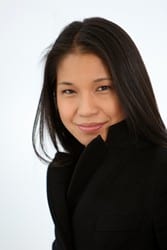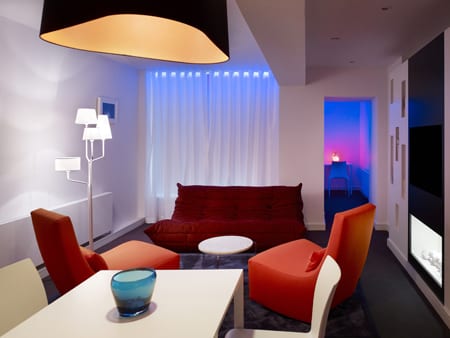Hospitality Design (HD) magazine and Culintro, a culinary trade organization in New York City that brings together restaurant professionals, have teamed up to present a monthly online Q&A with some of the nation’s top restaurant designers. Each month, we will feature a Q&A with an industry leader, talking about his/her newest project, the industry, what works, and what’s next.
Stephanie Goto
Founder, Stephanie Goto Design Group
New York
Stephanie Goto loves restaurants, everything about them. The native New Yorker grew up dining in the top restaurants with her parents. So it is quite serendipitous that she has made a career of designing them. And she is good at it, proven from the high-profile list of designers, owners, and chefs she has partnered with. She opens up about making things simpler, the importance of collaboration, and the restaurateur no one can do it better than.
HD: How did you get to where you are today?
SG: After architecture school I worked for six years for architect Rafael Viñoly. It was a 24-hour, 7-day-a-week job. My projects ranged from small scale to large buildings. It was my graduate school; I learned everything from design, business, politics, to management. I always had a passion for food so it was natural transition later when I had an opportunity to go on to hospitality design at the Rockwell Group.
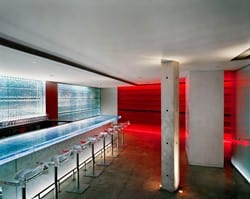 I started my practice working in collaboration with Tadao Ando on Morimoto [in New York]. It was an opportunity to use all of my skills: architecture, hospitality design, and Japanese.
I started my practice working in collaboration with Tadao Ando on Morimoto [in New York]. It was an opportunity to use all of my skills: architecture, hospitality design, and Japanese.
HD: Did you always know you wanted to be an architect?
SG: I always loved design as a child. I dreamed of creating an all-encompassing design practice from architecture to interiors, graphics, and fashion. By the time I was 13, my focus was very clear. All of my family vacations were centered on visiting architecture. I loved to live and breathe it anyway I could.
HD: How would you describe your office culture?
SG: We think of our office of five as a laboratory. Our brand is one that is derived from collaboration, research, and understanding the client’s story. It is interesting you ask about the culture of the office; it is in our DNA to be inspired by our context, clients, and challenges and seek opportunities were design may have an impact.
HD: What was your big break?
SG: The success of the studio is based on a sequence of events and building relationships and experiences each step of the way. Without one thing the next thing would have never happened. I always stress the importance of relationships. You never know when an opportunity may come your way.
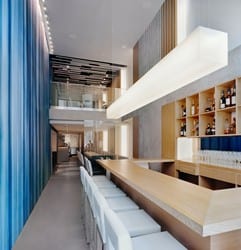 HD: Why do you love hospitality? Restaurants?
HD: Why do you love hospitality? Restaurants?
SG: I grew up in New York to great restaurants like the Quilted Giraffe with my parents; it is part of my DNA. Hospitality design is about creating an experience and telling a story; there are so many levels where design can make an impact. Restaurants in particular deal with all of the senses: seeing, tasting, hearing, touching, and smell. Curating a space that touches all of these things is challenging and rewarding.
HD: What is the greatest lesson you have learned?
SG: Having wonderful clients that inspire you and that you can inspire. Collaboration makes a project stronger; without a willingness to learn you will never grow as a designer.
HD: You worked on Stephen Starr’s Morimoto and Buddakan in New York. What was it like working with Christian Liaigre and Tadao Ando?
SG: Both Tadao Ando and Christian Liaigre are masters, and I learned so much form both of them. I was an apprentice but was able to understand them, gained their trust, and was a key part of the creation and execution of both restaurants.
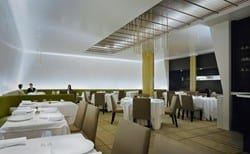 HD: More recently, you worked on two high-profile restaurants in New York—Corton and Aldea. Let’s start with Corton. How was it working with Drew Nieporent and chef Paul Liebrandt? What was the goal of the overall design aesthetic?
HD: More recently, you worked on two high-profile restaurants in New York—Corton and Aldea. Let’s start with Corton. How was it working with Drew Nieporent and chef Paul Liebrandt? What was the goal of the overall design aesthetic?
SG: The design of Corton was conceived as a salon in a hotel particulier (a French urban private house) inspired by the vision of Paul Liebrandt and imagined to set the stage and tell the story of his cuisine. We wanted the space to embrace the guest, so we gently canted the delicately engraved warm white walls so that the focus was on the food. Understated luxury with a bit of modern whimsy was part of he narrative and I think we achieved it. To work with two recognized names in the industry brought a lot of knowledge and precision to the creative process.
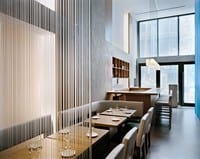 HD: Talk to us about Aldea. What was your concept? What was it like working with chef George Mendes?
HD: Talk to us about Aldea. What was your concept? What was it like working with chef George Mendes?
SG: Aldea’s story takes us to the Iberian Peninsula where the elements of nature water—wind, air, earth, and stone—became our inspiration set on a modern stage. Each of the design features evokes a feeling of nature but is not overt in any way. George was an integral part of the design process and I am very pleased to say that this project is tailor made to fit him.
HD: You have worked with some of the top restaurateurs. What is the key to success in working with chefs and operators?
SG: The culinary arts is very similar to architectural design in many ways. Both require a process, inspiration, and a narrative. Understanding the genesis of a chef’s cuisine is very important to the design process we take to create restaurant. Equally important is understanding the restaurant from an operations perspective: how do servers move around, where is the entrance to the kitchen, where are the waiter stations, how are they designed? If the service cannot function flawlessly it does not matter how beautiful the restaurant is.
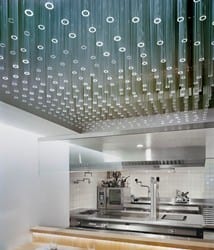 HD: Last summer you designed a wine-bar pop-up concept at the Museum of Arts and Design (MAD). How did you like it as a concept/trend?
HD: Last summer you designed a wine-bar pop-up concept at the Museum of Arts and Design (MAD). How did you like it as a concept/trend?
SG: All of the bars and seating elements were made from repurposed wine boxes, inserts, and pulps. The idea was that the bar could literally pop up and then collapse to be stored away. Since MAD is a museum focusing on materiality and process, our design insertion was a perfect fit. Each week we had a guest chef from one of the top restaurants in New York prepare food to which Crush Wine and Spirits paired an incredible wine selection. We had an average of 1,000-plus people visit the museum on each of the six nights. We were thrilled to be a part of it and are already planning this year’s version.
HD: We hate using the word trend, but what other new trends/concepts are happening in the restaurant industry?
SG: In my travels, I do see that restaurants from neighborhood spots to those with well know chefs are leaning towards smaller plates and more casual atmospheres, something without too much commitment. Even with this concept chefs are focusing on the integrity of ingredients and care in the execution. In a way, it takes more focus, care, and effort to make something simpler; this is true for design too.
HD: How are guests’ expectations changing in this economy/era? Are you doing anything different in your designs as a result?
SG: I feel that guests are looking for a value driven, approachable dining experience but still with an element of surprise. I believe Aldea is a leader in that field; it is so accessible but at the same time you learn so much for the thoughtfulness of the cuisine.
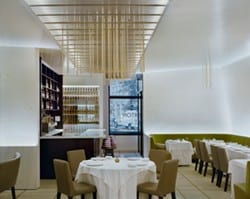 HD: As a native New Yorker, where are some of your favorite spots (that you didn’t design) to grab a drink or a bite?
HD: As a native New Yorker, where are some of your favorite spots (that you didn’t design) to grab a drink or a bite?
SG: The bar at Gramercy Tavern, it is my canteen. No one can do it better than Danny Meyer—what a classic. For sushi, Masa on a good night, 15 East on any night, and Sushi Seki late night. I like 11 Madison Park at the bar for Theo’s Pims cup or a glass of Billi Rose; Momofuku Saam Bar with five of my best friends and lots of amazing wine; and Bar Jamon, a late night pit stop after a long night of work for some Iberico and pan con tomate.
HD: Besides New York, what are your other favorite cities to dine in?
SG: Tokyo for the Japanese depth of culture, sensibility for the subtlety of taste, and incredible passion for presentation. Paris for L’Atelier de Joel Robuchon and all of the classics.
HD: What’s next for you? Any projects you are excited about?
SG: Bridging architecture design with fashion, lifestyle, wellness, and products; looking at the spatial experience more and more holistically; creating our first hotel.

